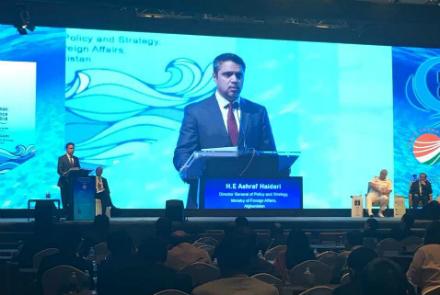Director-General of Policy and Strategy of The Afghan Ministry of Foreign Affairs Ashraf Haidari said on Wednesday that “the Taliban insurgency has enabled several terrorist networks with global and regional reach to operate out of Afghanistan.”
“At the same time, this imposed insecurity, has enabled a permissive environment for mass drug cultivation and production in Afghanistan, which now provides more than 90 percent of regional and global demand for drugs,” Haidari said at the Indian Ocean Conference 2018 themed “Building Regional Architectures”.
He said that in the past 17 years, Afghanistan has been a “victim of external aggression in the form of terrorism,” adding that “as a proxy of a coastal state, the Taliban have daily killed and maimed innocent Afghans, while destroying the infrastructure that should help connect and integrate Afghanistan with our surrounding resourceful regions in the North and South for increased trade, business and investment.”
In turn, revenue from the drug trade finance terrorism and fuel dysfunctional corruption that undermines governance and rule of law, which together destabilize drug producing and transit countries alike, he said.
He noted that because of the interconnectedness of these imposed security challenges, Afghanistan is facing a complex humanitarian crisis with diminishing human security.
“This makes our country a major source of refugees and asylum seekers, who are often ferried by human smugglers to Europe, Australia and elsewhere. As we see, what is imposed on and happens in countries like Afghanistan directly affect maritime security,” he said.
He pointed out that the best way to fight poverty that feeds terrorism is to foster political and security confidence-building through regional economic cooperation.
“The latter can serve as an important enabler in deepening connectivity, enhancing competitiveness and productivity, lowering transaction costs, and expanding markets in any region,” according to Haidari.
In turn he said Afghanistan has already put forth a number of strategic solutions for the adoption and implementation by the country’s coastal and landlocked neighbors; these include:
The Heart of Asia–Istanbul Process (HOA-IP);
The Regional Economic Cooperation Conference on Afghanistan (RECCA);
The Kabul Process for Peace and Security Cooperation;
The Joint Counter-Terrorism and Counter-Narcotics Strategy;
The Afghanistan-Pakistan Action Plan for Peace and Solidarity (APAPPS).
He also said that the Afghan government has worked hard to establish these Afghan-led processes to help secure regional cooperation for Afghanistan’s stabilization and sustainable development.
“It goes without saying that a stable Afghanistan at the heart of rising Asia will help ensure stability and prosperity throughout our surrounding regions. That is why it is in the best short- and long-term interests of coastal and non-coastal countries to participate in and to double and triple their efforts to achieve the shared goals of these regional security and development cooperation mechanisms,” he said.
In November, the 7th Regional Economic Cooperation Conference on Afghanistan (RECCA) took place in Ashgabat, Turkmenistan.
The conference focused on “Deepening Connectivity and Expanding Trade through Investment Infrastructure and Improving Synergy.”
RECCA remains a major opportunity for Afghanistan’s coastal and landlocked neighbors to take stock of the progress made so far, and, besides working together to address the challenges and bottlenecks, they should move on to commit the financing and investment needed with respect to the priority projects in the key areas of energy, transport networks, trade and transit facilitation, communications, and business-to-business and labor support, Haidari said.
He also said that the unimpeded implementation of the Chabahar Port—which involves Afghanistan, India, and Iran – is of importance, as it will further enhance connectivity through Afghanistan and facilitate our integration with the regional and global markets.
“As work continues this and other connectivity land and sea projects, we have launched air-corridors for trade, exporting Afghan products to markets near and far in the region,” he said.
Moreover, last December, the 7th Ministerial Conference of HOA-IP, with its political, security, and economic confidence-building measures implementation mechanism, took place in Baku, Azerbaijan.
Afghanistan aims at deepening synergies among the interconnected projects of RECCA and HOA-IP, maximizing their impact on sustainable development not only in Afghanistan but also throughout our surrounding regions, he said.
“This should encourage the country-participants to assess their shared security and development needs and to bolster their engagement with Afghanistan accordingly, in order to initiate the implementation of the proposed projects with win-win benefits,” Haidari said.
He said that because sustainable development is impossible without durable stability, last year, Afghanistan re-launched the Kabul Process for Peace and Security in Afghanistan.
“Through this Afghan-owned and Afghan-led process, a results-oriented peace strategy has been laid out, the key purpose of which is to engage in unconditional, direct talks with the Taliban. Our peace strategy aims to separate reconcilable Taliban insurgents from transnational terrorist networks. But to succeed in this endeavor, we reply on honest and tangible regional cooperation, foremost on the closure of the sanctuaries and other forms of support, which the Taliban enjoy in the region,” according to Haidari.
He says that in parallel to our peace strategy, the Afghan government is pursuing a joint counter-terrorism and counter-narcotics strategy.
The two strategies mutually reinforce one another, as our counter-terrorism and counter-narcotics efforts not only contribute to similar efforts at the regional and global levels but also advance Afghan peace efforts by increasing the number of reconcilable Taliban, who otherwise would refuse to discontinue violence, he said.
In addition, the Afghan government has worked hard to engage with Pakistan on a state-to-state basis to secure the country’s cooperation both in fighting terrorism with no distinction and in persuading the Taliban leadership to participate in the intra-Afghan peace process for a political negotiated settlement, he said.
In this regard, the inaugural meeting of the Afghanistan-Pakistan Action Plan for Peace and Solidarity (APAPPS) took place in Kabul in late July, as the APAPPS five working groups discussed issues of counter-terrorism, intelligence-sharing, peace efforts, trade and investment, and refugees, he added.
“For our part, the Afghan side firmly committed to working with relevant Pakistani institutional stakeholders to implement the key goals of the five working groups, in line with the core principles of the APAPPS agreed between Afghanistan and Pakistan,” he mentioned.
He also said that considering these major opportunities for regional security and development cooperation, “we welcomed and strongly support the South Asia strategy of the United States.”
The strategy has followed a conditions-based approach to helping stabilize Afghanistan, and its key objective is to help close terrorist safe sanctuaries in Pakistan. Success in this necessary endeavor should help reduce violence across Afghanistan, compelling the Taliban to opt for peace, an outcome desired by every Afghan.
“That is why we strongly believe that the full execution of the US strategy, in partnership with coastal and littoral states that share Afghanistan’s security and development interests, will not only help stabilize our country but also ensure security as a precondition for sustainable development across our surrounding regions in the Asian continent,” he added.


